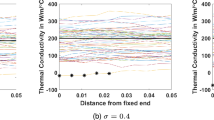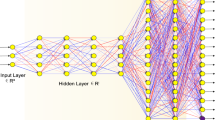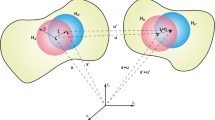Abstract
Based on the deep energy method recently brought forward to handle linear-elastic or hyper-elastic finite deformation problems in solid mechanics, in this paper, we propose a deep heat energy method (DHEM) which is specially tailored to deal with structural steady-state heat conduction problems with the help of deep learning techniques. In our work, the deep neural networks are utilized to construct the admissible temperature fields; secondly, the potential energy functional in the heat conduction process which works as the loss function of the deep neural networks is calculated by numerical integration techniques; finally, the parameters of the network including weights and bias, are optimized by the quasi-Newton method to yield the minimal of the potential energy functional which indicates the heat conduction has entered a steady state. Numerical examples with a diversity of materials, including the isotropic and homogeneous material, the orthotropic material, the non-homogeneous materials and temperature dependent materials, are carried out to illustrate the validity and capacity of DHEM in both linear uncoupled and thermal-material coupling heat conduction problems.
Similar content being viewed by others
Abbreviations
- κ :
-
Thermal conductivity coefficient
- T :
-
Structural temperature
- T e :
-
Medium temperature
- q :
-
Heat source intensity
- \({\bar h_c}\) :
-
Heat transfer coefficient
- w :
-
Network weights
- b :
-
Network bias
References
K. Morgan, R. Lewis and O. Zienkiewicz, An improved algorithm for heat conduction problems with phase change, International Journal for Numerical Methods in Engineering, 12 (1978) 1191–1195.
J. R. Chang, C. S. Liu and C. W. Chang, A new shooting method for quasi-boundary regularization of backward heat conduction problems, International Journal of Heat and Mass Transfer, 50(11–12) (2007) 2325–2332.
S. Y. Kadioglu and D. A. Knoll, A fully second order implicit/explicit time integration technique for hydrodynamics plus nonlinear heat conduction problems, Journal of Computational Physics, 229(9) (2010) 3237–3249.
B. Jin, Z. Yao and L. Marin, The method of fundamental solutions for inverse boundary value problems associated with the steady-state heat conduction in anisotropic media, International Journal for Numerical Methods in Engineering, 65(11) (2010) 1865–1891.
D. Wang, X. Lu, Y. Song, S. Rong and Q. Tian, Influence of the temperature dependence of thermal parameters of heat conduction models on the reconstruction of thermal history of igneous-intrusion-bearing basins, Computers and Geosciences, 36(10) (2010) 1339–1344.
G. F. Dargush and P. K. Banerjee, Advanced development of the boundary element method for steady-state heat conduction, International Journal for Numerical Methods in Engineering, 28(9) (2010) 2123–2142.
Y. Kai and X. W. Gao, Radial integration bem for transient heat conduction problems, Engineering Analysis with Boundary Elements, 34(6) (2010) 557–563.
W. K. Liu and T. Belytschko, Efficient linear and nonlinear heat conduction with a quadri-lateral element, International Journal for Numerical Methods in Engineering, 20(5) (2010) 931–948.
H. Ahmadikia and M. Rismanian, Analytical solution of non-fourier heat conduction problem on a fin under periodic boundary conditions, Journal of Mechanical Science and Technology, 25(11) (2011) 2919–2926.
J. J. Wang, R. T. Zheng, J. W. Gao and G. Chen, Heat conduction mechanisms in nanofluids and suspensions, Nano Today, 7(2) (2012) 124–136.
R. J. Moitsheki and B. H. Bradshaw-Hajek, Symmetry analysis of a heat conduction model for heat transfer in a longitudinal rectangular fin of a heterogeneous material, Communications in Nonlinear Science and Numerical Simulation, 18(9) (2013) 2374–2387.
S. A. Yousefsani and M. Tahani, An analytical investigation on thermomechanical stress analysis of adhesively bonded joints undergoing heat conduction, Archive of Applied Mechanics, 84(1) (2014) 67–79.
G. M. Kulikov and S. V. Plotnikova, Heat conduction analysis of laminated shells by a sampling surfaces method, Mechanics Research Communications, 55 (2014) 59–65.
G. X. Yu, J. Sun, H. S. Wang, P. H. Wen and J. W. Rose, Meshless inverse method to determine temperature and heat flux at boundaries for 2d steady-state heat conduction problems, Experimental Thermal and Fluid Science, 52 (2014) 156–163.
A. Krizhevsky, I. Sutskever and G. Hinto, ImageNet classification with deep convolutional neural networks, Advances in Neural Information Processing Systems, 25 (2012) 1097–1105.
I. J. Goodfellow, J. Pouget-Abadie, M. Mirza, B. Xu, D. Warde-Farley, S. Ozair, A. Courville and Y. Bengio, Generative adversarial networks, Advances in Neural Information Processing Systems, 3 (2014) 2672–2680.
L. Dinh, D. Krueger and Y. Bengio, NICE: non-linear independent components estimation, arXiv:1410.8516v6 (2014).
L. Dinh, J. Sohl-Dickstein and S. Bengio, Density estimation using real NVP, arXiv:1605.08803v3 (2016).
V. Mnih, K. Kavukcuoglu, D. Silver, A. Rusu, J. Veness, M. Bellemare, A. Graves, M. Riedmiller, A. Fidjeland, G. Ostrovski, S. Petersen, C. Beattie, A. Sadik, I. Antonoglou, H. King, D. Kumaran, D. Wierstra, S. Legg and D. Hassabis, Human-level control through deep reinforcement learning, Nature, 518(2) (2015) 529–533.
E. Samaniego, C. Anitescu, S. Goswami, V. M. Nguyen-Thanh, H. Guo, K. Hamdia, X. Zhuang and T. Rabczuk, An energy approach to the solution of partial differential equations in computational mechanics via machine learning: concepts, implementation and applications, Computer Methods in Applied Mechanics and Engineering, 362(15) (2020) 112790.1–112790.29.
V. M. Nguyen-Thanh, X. Zhuang and T. Rabczuk, A deep energy method for finite deformation hyperelasticity, European Journal of Mechanics — A/Solids, 80 (2020) 103874.
H. Ma, X. Hu, Y. Zhang, N. Thuerey and O. Haidn, A combined data-driven and physics-driven method for steady heat conduction prediction using deep convolutional neural networks, arXiv:2005.08119v1 (2020).
H. Chen, Z. Du, X. Li, H. Zhou and Z. Liu, Identification of pipe inner surface in heat conduction problems by deep learning and effective thermal conductivity transform, Engineering Computations, 37(9) (2020) 3505–3523.
X. Chen, X. Chen, W. Zhou, J. Zhang and W. Yao, The heat source layout optimization using deep learning surrogate modeling, Structural and Multidisciplinary Optimization, 62 (2020) 1–22.
Acknowledgments
The authors acknowledge the financial support from the Fundamental Research Funds for the Central Universities under JLU (93K172020K28), we would like to express our sincere thanks to the Key Laboratory of Symbolic Computation and Knowledge Engineering of Ministry of Education, Jilin University.
Author information
Authors and Affiliations
Corresponding author
Additional information
Zengming Feng is a Professor of the School of Mechanical and Aerospace Engineering, Jilin University, China. His research fields include mechanical transmission and dynamic control, multi-body dynamic modeling and simulation, friction and wear.
Rights and permissions
About this article
Cite this article
Gao, H., Zuo, W., Feng, Z. et al. DHEM: a deep heat energy method for steady-state heat conduction problems. J Mech Sci Technol 36, 5777–5791 (2022). https://doi.org/10.1007/s12206-022-1039-0
Received:
Revised:
Accepted:
Published:
Issue Date:
DOI: https://doi.org/10.1007/s12206-022-1039-0




